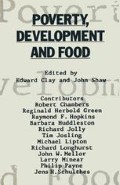Abstract
Just now there is something of a crisis of confidence in the field of applied nutrition. This may perhaps seem strange, indeed irritating to many people, in the light of so much dramatic evidence of acute starvation as well as the widespread persistence of chronic hunger. In past years, a chapter such as this might have begun with a review of the extent of different kinds of nutritional deficiency diseases and their differential causes, and would then have proceeded to describe appropriate interventions: correction of nutrient deficiencies (vitamins, minerals, and especially proteins); education programmes to correct cultural ‘errors’ in the use or intra-household distribution of different foods, or to correct distortions of consumer behaviour due to rapid socio-economic changes; food distribution programmes intended to bring immediate relief to those presently unable to afford an adequate diet. Now, after a very substantial investment on an international scale in basic and applied research, and in evaluation of such programmes, C. Gopalan (1980) writing about India says:
We have therefore to conclude that during the last 30 years, in spite of all our advances in the agricultural, industrial and technological fields, and in spite of several ‘applied nutrition programmes’ and ‘supplementary feeding programmes’, we have not really made any significant dent on the problem of malnutrition in our children. We have reduced infant and child mortality to some extent and we have thus ‘saved’ many children whom, otherwise, the merciful hand of death would have removed. There is thus an increasing pool of survivors who have escaped death but who exist in a substandard state of health and nutrition with permanent impairment of functional competence and productivity. The result is a progressive erosion and deterioration of the ‘quality’ of our human resources.
Access this chapter
Tax calculation will be finalised at checkout
Purchases are for personal use only
Preview
Unable to display preview. Download preview PDF.
References
BARRETT, D. E. (1984) ‘Malnutrition and child behaviour: conceptualisation of social-emotional functioning and a report on an empirical study’, in Malnutrition and Behaviour: Critical Assessment of Key Issues, Nestle Foundation Publication Series, vol. 4 (Lausanne, Nestle Foundation) pp. 280–306.
BARRETT, D. E. et al. (1982) ‘Chronic malnutrition and child behaviour: effects of early caloric supplementation on social and emotional functioning at school age’, Development Psychology, vol. 18(4), pp. 541–56.
BEATON, G. H. AND H. GHASSEMI (1979) Supplementary Feeding Programmes for Young Children in Developing Countries, Report prepared for UNICEF and the ACC-SCN of the United Nations (Rome: FAO).
CALLOWAY, D. H. et al, (1980) Collaborative Research Support Programme on Intake and Function: Final Report to the US Agency for International Development, Department of Nutritional Sciences (Berkeley: University of California).
CHAMBERS, R. (1983) Rural Development: Putting the Last First (London: Longman).
CHRISTIANSEN, N. (1984) ‘Social effects of a family food supplementation and a home stimulation programme’, in Malnutrition and Behaviour: Critical Assessment of Key Issues, Nestle Foundation Publication Series, vol. 4 (Lausanne: Nestle Foundation) pp. 520–30.
FRANK, D. A. (1984) ‘Malnutrition and child behaviour: a view from the bedside’, in Malnutrition and Behaviour: Critical Assessment of Key Issues, Nestle Foundation Publication Series, vol. 4 (Lausanne: Nestle Foundation) pp.307–26.
GOPALAN, G. (1980) Thirteen Jawarharlal Nehru Memorial Lecture, Jawarharlal Nehru Memorial Lectures (New Delhi: Jawarharlal Nehru Memorial Fund, Teen Murti House) pp. 125–50.
GRANTHAM-McGREGOR, S. (1984) ‘The social background of childhood malnutrition’, in Malnutrition and Behaviour: Critical Assessment of Key Issues, Nestle Foundation Publication Series, vol. 4 (Lausanne: Nestle Foundation) pp. 358–74.
GWATKIN, D. R. et al., (1980) ‘Can health and nutrition interventions make a difference?’, Monograph, no. 13 (Washington DC: Overseas Development Council).
MARGEN, S. (1984) ‘Energy-protein malnutrition: a web of causes and consequences’, in Malnutrition and Behaviour: Critical Assessment of Key Issues, Nestle Foundation Publication Series, vol. 4 (Lausanne: Nestle Foundation) pp. 20–31.
PAYNE, P. and P. CUTLER (1984) ‘Measuring malnutrition: technical problems and ideological perspectives’, Economic and Political Weekly, vol. 19(34), 25 August, pp. 1485–92.
POPPER, K. R. (1965) The Open Society and its Enemies, 5th ed (London: Routledge & Kegan Paul).
PRIGOGINE, I. and I. STENGER (1985) Order out of Chaos (London: Fontana).
SCHAFFER, B. and G. LAMB (1981) Can Equity be Organised? (Farnborough: Gower).
SECKLER, D. (1982) ‘Small but healthy: a basic hypothesis in the theory, measurement and policy of malnutrition’, in Newer Concepts in Nutrition and their Implications for Policy (Pune, India: Maharashtra Association for the Cultivation of Science Research Institute) pp. 127–48.
SUKHATME, P. V. (1961) ‘The world’s hunger and future needs in food supplies’, Journal of the Royal Statistical Society Series A, vol. 124, pp. 463–525.
SUKHATME, P. V. (1977) ‘Incidence of undernutrition’, Indian Journal of Agricultural Economics, vol. 32(3), pp. 1–7.
SUKHATME, P. V. (1982) in Newer Concepts in Nutrition and their Implications for Policy (Pune, India: Maharashtra Association for the Cultivation of Science Research Institute) pp. 127–48.
WATERLOW, J. C. et al., (1977) ‘The presentation and use of height and weight data for comparing the nutritional status of groups of children under the age of 10 years’, WHO Bulletin, no. 55, pp. 489–98.
Editor information
Editors and Affiliations
Copyright information
© 1987 Philip Payne
About this chapter
Cite this chapter
Payne, P. (1987). Malnutrition and Human Capital: Problems of Theory and Practice. In: Clay, E., Shaw, J. (eds) Poverty, Development and Food. Palgrave Macmillan, London. https://doi.org/10.1007/978-1-349-09214-7_3
Download citation
DOI: https://doi.org/10.1007/978-1-349-09214-7_3
Publisher Name: Palgrave Macmillan, London
Print ISBN: 978-1-349-09216-1
Online ISBN: 978-1-349-09214-7
eBook Packages: Palgrave Social & Cultural Studies CollectionSocial Sciences (R0)

